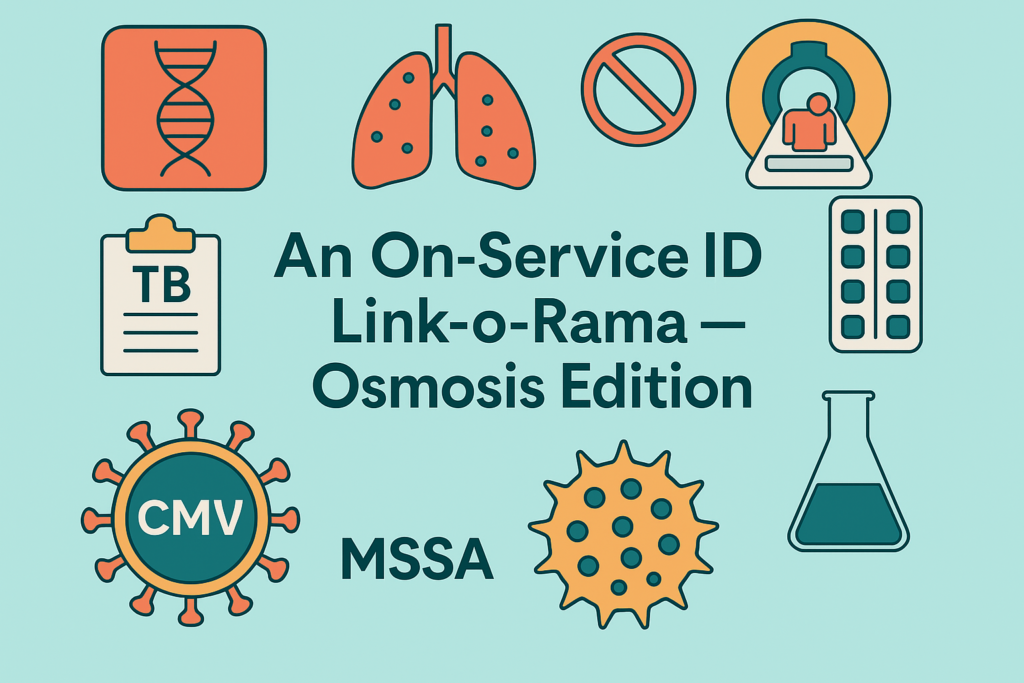An ongoing dialogue on HIV/AIDS, infectious diseases,
April 30th, 2025
On-Service ID Link-o-Rama — Osmosis Edition
 First-year ID fellows this time of year bring a lot to inpatient consult rotations. Years of high-volume inpatient care have sharpened their clinical instincts, and at this point they have an impressive fund of ID knowledge. Plus, the fellow on our current rotation gets along great with everyone — patients and consulting clinicians alike — a remarkable and under-appreciated talent that really brings joy to the experience of being on the “ID Team.”
First-year ID fellows this time of year bring a lot to inpatient consult rotations. Years of high-volume inpatient care have sharpened their clinical instincts, and at this point they have an impressive fund of ID knowledge. Plus, the fellow on our current rotation gets along great with everyone — patients and consulting clinicians alike — a remarkable and under-appreciated talent that really brings joy to the experience of being on the “ID Team.”
What ID fellows emphatically don’t have, however, is lots of free time — hence non-medical, non-ID things appropriately take priority in what little free time they have. That laundry isn’t going to wash, dry, and fold itself. You wish.
Because first-year fellows are so busy, I tell them they’ll get emails from me pretty much each day with at least one relevant study, something I’ve very briefly cited on rounds. Here’s the important part: I also tell them they do not need to respond, or even to read the referenced paper. It’s for subconscious learning, a kind of literature osmosis — something I’m sending in their general direction now that might seep into their brains for the future.
So here’s a bunch of them from this rotation, with some bare-bones commentary.
The Best Way to Rule Out Active TB. In head-to-head comparisons, Xpert MTB/RIF outperformed AFB smear in ruling out pulmonary TB — useful both in low- and high-prevalence settings. Two negative tests in the U.S. had a 100% negative predictive value for active TB. The amount of energy, time, and money spent — some might say wasted — ruling out TB in low-likelihood cases here never ceases to astound me; on the other hand, cases of unrecognized TB can be disastrous both clinically and from a cost perspective. Still, in low-risk patients, it’s the infection control version of everyone being forced to take off shoes before going through security at the airport.
Drug Hypersensitivity to Antibiotics That Aren’t Beta-Lactams. Fluoroquinolones, vancomycin, tetracyclines, and macrolides all can rarely trigger immediate (type 1) hypersensitivity reactions (HSRs). It can be particularly tricky with severe vancomycin infusion reactions, as these can mimic type I HSRs with angioedema, chest pain, dyspnea, bronchospasm, and hypotension. Mast cells doing their mast cell thing.
Inhaled Amikacin for Refractory Pulmonary Mycobacterium avium Complex (MAC). This pivotal trial led to FDA approval of inhaled liposomal amikacin for pulmonary MAC, showing a higher culture conversion rate for amikacin (29%) compared to standard therapy alone (9%). A high proportion of participants got side effects like hoarseness and bronchospasm, so be prepared if you use it. I highlight the study here because it’s one of the rare controlled clinical trials in this very common condition, a glaring data gap we feel just about every day in ID practice. As a result, nontuberculous mycobacterial (NTM) pulmonary disease remains fertile ground for anecdotes and strong opinions — more good studies would be welcome!
CMV Reactivation in the ICU: Treat or Don’t Treat? Short answer for immunocompetent patients: don’t treat. This randomized clinical trial was stopped early due to worse outcomes with valganciclovir. It’s still unknown what to do in immunocompromised patients.
Myasthenia Gravis and Antibiotics: Caution with Fluoroquinolones and Macrolides. Prior to this rotation, I had thought that only aminoglycosides exacerbated this condition, but it turns out other drug classes can do the same. A fund-of-knowledge lacune for me. Credit to my current fellow who taught me this, so here’s to the bidirectional flow of knowledge that happens every rotation! Yay!
Crushing BIC/FTC/TAF for HIV Treatment. Good news: Based on this study presented at CROI 2025 by some of my brilliant ID pharmacist colleagues, crushing bictegravir/emtricitabine/tenofovir alafenamide for tube feeds seems feasible for patients unable to swallow whole tablets. And for those who don’t do HIV medicine on the inpatient service, trust me — this comes up a lot.
In HIV, Hospitalization for Acute Infections Markedly Lowers CD4 Cell Counts. While the linked study looked only at pneumonia caused by Streptococcus pneumoniae in people with HIV not on ART, this phenomenon also happens with suppressive ART — which can be very scary to those not in the know. However, the CD4/CD8 ratio is not influenced, and counts will recover when the illness resolves.
How Long to Treat Spinal Osteomyelitis? An exception to the “shorter is better” rule, this observational trial suggests 6 weeks isn’t always enough. Longer therapy for high-risk cases (especially due to MRSA) may be warranted; I find CRP monitoring helpful in these cases. Importantly, oral rather than IV therapy makes this a much more viable strategy.
That last one is a good transition to a designated Staph aureus section, in honor of the first-year ID fellow’s primary nemesis:
Cefazolin and Ertapenem for Persistent MSSA Bacteremia. It’s hard to believe that patients can have days or even weeks of positive blood cultures despite appropriate antibiotics with this nasty bug, but it’s a common enough consult for ID doctors that we see this repeatedly. This case series reported rapid clearance with the combination of cefazolin plus ertapenem, the two antibiotics targeting different penicillin-binding proteins. Bonus: They included an animal endocarditis model showing lower vegetation bacterial counts with combination therapy.
Does PET/CT Actually Improve Mortality in Staph aureus Bacteremia? Maybe not. This clever analysis highlighted “immortal time bias” — patients need to survive long enough to get the scan, making survival look artificially better than those who don’t get the scan. Once adjusted for this bias, PET/CT was no longer associated with improved outcomes. By the way, both the combination ertapenem and cefazolin treatment and this PET/CT issue are part of the SNAP trial. Amazing!
Cefazolin for CNS Infections due to Staph aureus — the Debate Continues. Probably it’s ok, as pharmacokinetic data suggest it may provide even better drug levels than nafcillin and oxacillin, and clinical failures with breakthrough infection are rare. But not everyone is convinced. Certainly will be interested to see what the SNAP trial teaches us with this population. (H/T to Dr. Jonathan Blum for these references.)
Quantitative Microbial Cell-Free DNA Sequencing from Plasma Can Help Diagnose Cardiac Implantable Electronic Device Infections. Not everyone with implantable cardiac devices and staph bacteremia has device infection. In this study, patients with definite infection had DNA levels (as measured by the Karius assay) that persisted during antibiotic therapy, spiked after device extraction, then declined rapidly. Conversely, in patients with only possible infection, levels became undetectable after several days of antibiotics and remained so post-extraction. The test could one day become a standard part of monitoring these patients, though today such a strategy would be prohibitively expensive.
So that’s a wrap — a bunch of papers sent with zero expectation they’d be read immediately by the fellow on our ID team, even though she’s outstanding! But maybe one or two will seep in via osmosis — or (to switch metaphors mid-sentence), stick like that song you heard once, and now know forever.


Another great posting, Dr. Sax. The ID fellow to whom you allude is very fortunate, indeed, to have you as a mentor. Wish I could have had that experience!
Dr Sax does indeed seems to be a superb human being , an extraordinary Physician , an inquisitive investigator , a skillful clinician and also a master teacher and mentor . I was also very fortunate to have Dr Martin J. Raff as my mentor during my years of fellowship in Infectious Diseases .
Quick, bite-sized info is always valuable for our fellows, young collegues with busy schedules. We do our best to explain things too, but not every topic gets discussed all the time. Mention something once if you see it once; talk about it daily if you see it every day. Thanks so much, I’m sharing it with our team as well.
Dear Paul,
I appreciate your blog postings – they are educational and easy to digest. I frequently forward them to fellows and residents.
One small correction – I think there’s an error in your CMV study blurb. Unless I’m reading it wrong, the study was stopped early due to worse outcomes with valAcyclovir, not valGANcyclovir.
Thanks for your all your work and keep the posts coming!
– Saumil
This one was with valganciclovir.
-Paul